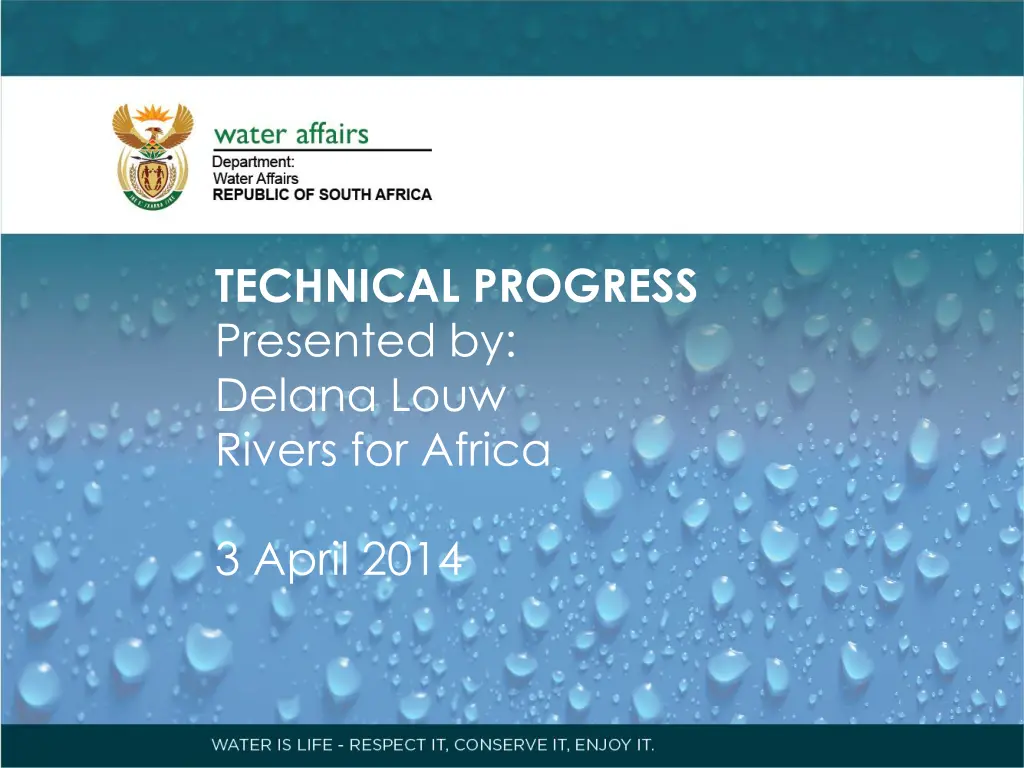
Technical Progress Presented by Delana Louw: Project Plan & Study Tasks
"Explore the technical progress presented by Delana Louw for Africa, focusing on project plan, study tasks, and steps involved in determining management classes and consequences within Integrated Water Resource Management (IWRM)."
Download Presentation

Please find below an Image/Link to download the presentation.
The content on the website is provided AS IS for your information and personal use only. It may not be sold, licensed, or shared on other websites without obtaining consent from the author. If you encounter any issues during the download, it is possible that the publisher has removed the file from their server.
You are allowed to download the files provided on this website for personal or commercial use, subject to the condition that they are used lawfully. All files are the property of their respective owners.
The content on the website is provided AS IS for your information and personal use only. It may not be sold, licensed, or shared on other websites without obtaining consent from the author.
E N D
Presentation Transcript
TECHNICAL PROGRESS Presented by: Delana Louw Rivers for Africa 3 April 2014
PROJECT PLAN & STUDY TASKS Complete In process TECHNICAL STEPS 1. Status quo, IUA delineation OTHER STEPS 2b Stakeholder process 3. Quantify EWRs & links to EGSA 8. Capacity Building 2a Visioning 8. Gazetting 4. ID & evaluate scenarios in IWRM 5. Evaluate scenarios with stakeholders and determine MC 6. RQO
STEP 1: STATUS QUO & IUA DELINEATION Purpose of task was to select IUAs, and to determine the status quo of the IUAs. 12 IUAs identified, each with nodes. The output in essence is a sustainable base configuration that equates to the present state. Changes in this status are measured when evaluating operational scenarios within IWRM (Step 4). Hotspots were identified that links to the prioritising of RU for RQO determination
STEP 3: QUANTIFY EWRS AND LINKS TO EGSA Purpose of task was to determine EWRs at each biophysical node. EGSAs are identified and key EGSA that can change with changes with scenarios highlighted. Output is EWRs as flow duration tables for each node. The EWRs informs the flow component of RQOs
STEP 4 & 5: ID & EVALUATE SCs WITHIN IWRM Determine preliminary operational scenarios and test with stakeholders (previous PSC meeting) Next: Determining consequences of scenarios presented in this meeting. Ranking scenarios presented in this meeting Determine draft Management Classes presented in this meeting
STEP 4, 5, 7: MC DETERMINATION PROCESS Identify operational scenarios User water quality consequences EcoSystem Services consequences Economic consequences Determine Status Quo Ecological consequences CHANGE FROM STATUS QUO? (PREDICT CONSEQUENCES) Draft Select future operational scenario Management Classes for each Scenario MANAGEMENT CLASS Presented and or discussed during THIS meeting.
RECAP OF PROCESS TO DETERMINE MC Test scenarios and associated MC with stakeholders Select scenario and draft MC Consider trade- offs Recommended MC RQO DWA decision determination Gazetting process Presented and or discussed during THIS meeting. MC (& CATCHMENT CONFIGURATION) & RQOs GAZETTED
STEP 6: RESOURCE QUALITY OBJECTIVES THE FOLLOWING STEPS HAVE ALREADY BEEN ADDRESSED WITHIN THE INTEGRATED STEPS: Delineate IUAs & define RUs Visioning Prioritise RUs Select and prioritise components in each RU as well as indicators Draft RQOs and set numerical limits Agree on RUs, RQOs, numerical limits. Gazette RQOs
STEP 6: RESOURCE QUALITY OBJECTIVES In summary: Priority RUs for RQOs selected Indicators and driving variables selected. Narrative RQOs available. Numerical RQOs available or being finalised Gazetting information in process
WHERE TO FROM HERE In summary: Consequences and MC report provided for comment. RQO report will be provided for comment. Public meeting.
